Bell Airacobra, Ballysop, Co. Wexford, February 1943
An Irish Army intelligence branch memo dated 6 February 1943,
summarizes the events of the preceding day which found an
American fighter plane land in a field near Campile town.
This memo was for distribution to the Minister for Defence, the
Army Chief of Staff and his assistant, the secretary's of the
Departments of External Affairs and of Defence and the officer
Commanding, Air Corps.
Previous Movements of aircraft: An
American aircraft first observed by L.O.P. Forlorn Point at
12.39 hrs. on 5th February, 1943, one mile N.E. moving N.W.
was subsequently observed by Garda Passage East over post
moving S.S.W. to L.O.P. Brownstown where it was observed 1/2
mile S. moving E. It was later observed by military
Dunmore East over post moving N.E. to Waterford where it was
observed 1/2 mile W. moving S.E. to Campile where it was
last observed over post moving N.E.
Place and Time of landing: The
aircraft landed in a field 3 miles north of Campile, Co.
Wexford, at 14.00 hrs. on 5/2/43.
Nationality and type of aircraft
involved: An American Aira-Cobra Single-engined
Fighter aircraft. No. on Rudder 24518.
Particulars of Crew: The pilot, who
was the only occupant, was uninjured. Name: 2/Lieut.
Charles M. Kirschen*,
U.S. Air Force. No. O885369.
Condition of aircraft: The
undercarriage and propeller of the aircraft are damaged.
Armament: The aircraft was armed with
6 M.Gs., 1 Cannon and some ammunition.
Cause of landing: Loss of
bearings and wireless trouble.
Mission: The pilot states he was on an
operational**
flight from the south of England.
* 2/Lt Kirschner's
name is spelled incorrectly in a number of the Army report
pages.
** The word operational is underlined on one copy of this
memo in the file. A follow on document, dated the 19th
February 1943, from the same source and to the same
distribution list recorded that following interrogation of
the pilot, and investigation of the aircraft, is was
determined that he was not on an operational flight at the
time of the crash.
The following
photos of the crashed aircraft was found locally by
researcher Sean Egan and are understood to have been taken
by a local man, Justin Egan. It had been used on a
local football club calendar. In the photo one can see
on the tail the numbers 245 and traces of the 18.
USAAF aircraft carried their serial numbers in an
abbreviated format, with leading digit of the year and the
dash left off, hence 42-4518 would be displayed as
24518. A number of bystanders are clearly visible in
the background.
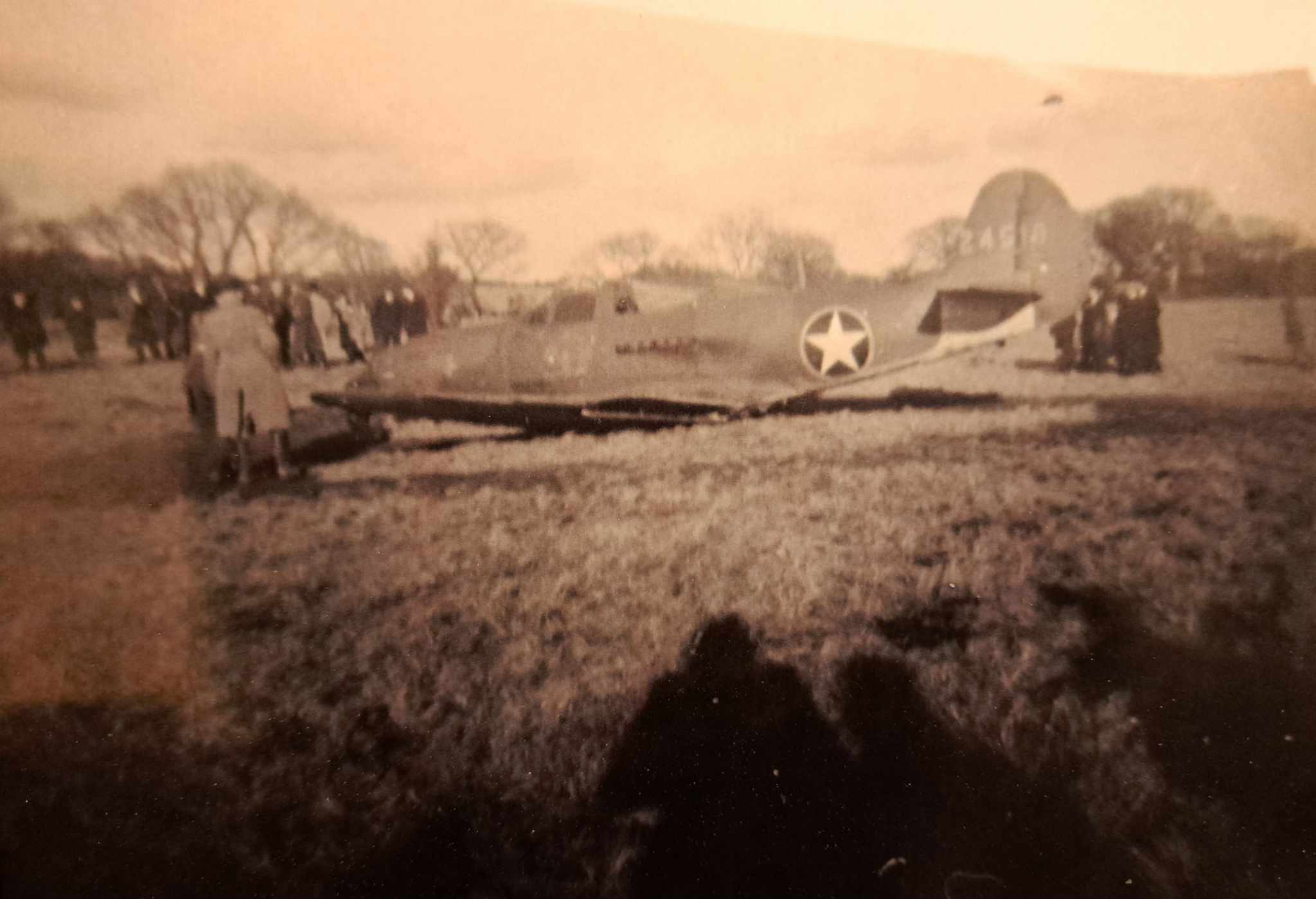
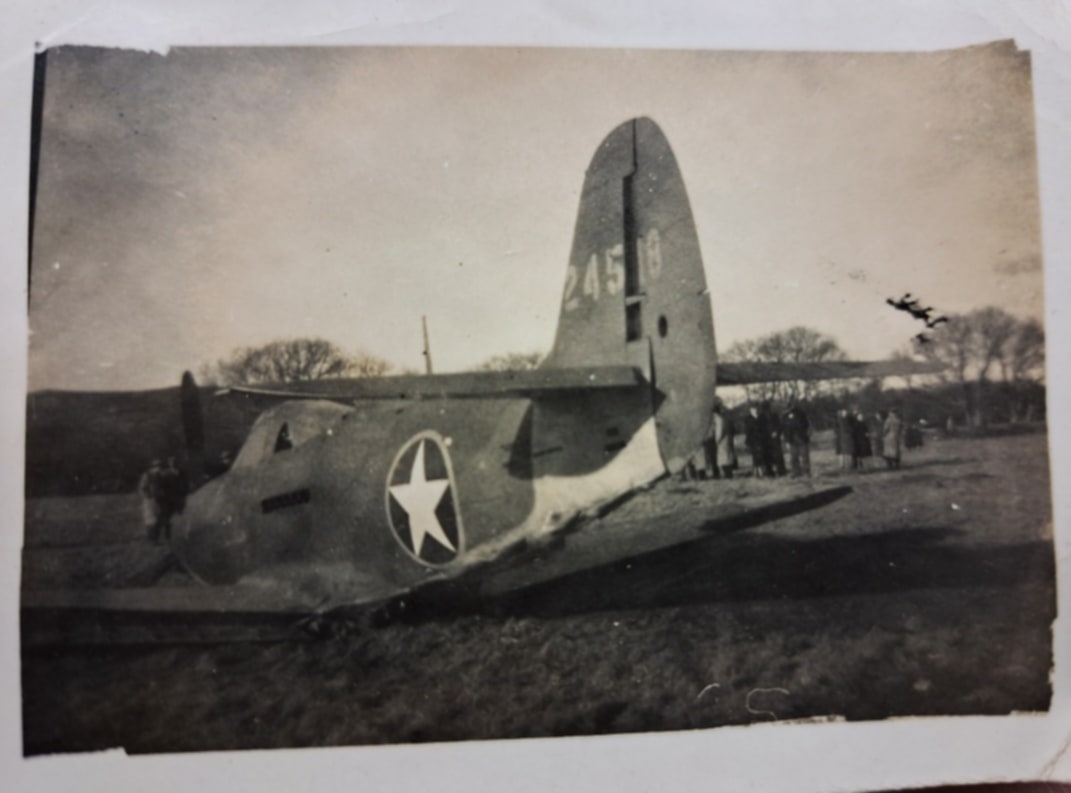
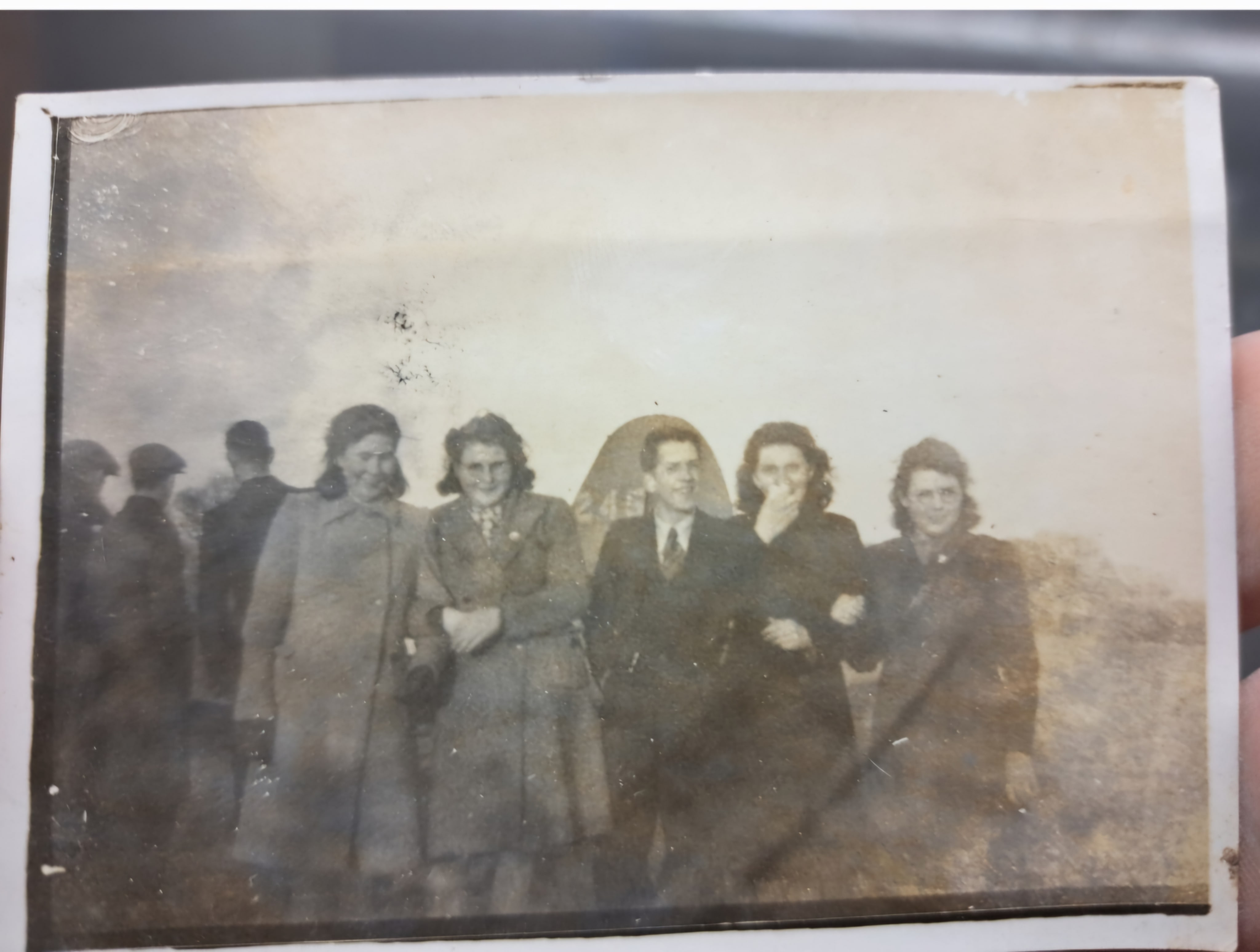
There doesn't appear to be a detailed mention of how Lt
Kirschner was disposed of within the Irish Army file however,
from the salvage reports, he was in the company of the US
Attache Col. Hathaway on the morning of Lt J Ryan's arrival
below, and it can assumed that he was driven to the border on
the evening after the crash landing. Its not clear where
he was accommodated over night on the 5th/6th February but it
may have been with the local Irish Army unit.
Lt J Ryan of the Irish Air Corps Workshops branch attended at
to the aircraft with a salvage party and provided a 10 page
report on in observances and actions. He described the
scene as: It had landed with the
undercarriage retracted and must have stalled before
touching down as it appeared to have traveled only about 30
feet before coming to rest. The underside of the
fuselage was torn and dinged from the center section aft to
the rudder. The starboard wing tip was crumpled while
the aftermost spar of the port wing appeared to be badly
bent and the skin on the upper side of the wing was bulged.
The Irish Army file contains a typed copy of a receipt dated 5th February 1943 listing the property found in the plane and is signed in person by 2nd Lt Kirschner.
Salvage operations
by an Irish Air Corps team took place between the 8th and
12th February. Irish Army officers reported that a
considerable amount of damage was caused to the aircraft
after its arrival in Wexford, and while it was under guard
by Irish military personnel.
Lt John Ryan of the
Irish Air Corps, Workshops Branch, filed two long
handwritten accounts of the salvage and later, journey of
the dismantled Airacobra from Wexford to Baldonnel aerodrome
outside Dublin and onwards to the border with Northern
Ireland.
When I arrived at the aircraft it was
under careful military guard with an officer in charge.
The pilot had retained the keys of the aircraft and
without these it was impossible to gain access to the
cockpit. About half an hour later the American Air
attache, Col. Hathaway, accompanied by the pilot, Lt
Kirschner, and escorted by an officer from G2 branch
arrived on the scene. Colonel Hathaway took me apart and
requested that the pilot should be allowed to go aboard
the plane and explode the detonator fixed in his special
radio set which was mounted under a perspex hood behind
the cockpit. He explained that the pilot would get
into serious trouble if this were not done as he should
have destroyed the set immediately he landed. I told
Col. Hathaway that we had often salvaged similar sets
intact before now and that it would doubtless be
returned to him untouched. He stated that if the
set were returned to him he would explode it
himself. In view of this statement and as I knew
that our Signal Corps had no necessity to acquire such a
set I cleared away the bystanders and allowed the pilot
aboard. He exploded the detonator and destroyed
the set, the perspex hood at the back of the cockpit
being broken by the explosion.
Under my supervision the pilot then removed all his
personal gear from the plane and had them removed to the
car in which he came. He left an ammunition
container full of cigarettes, chocolate and tinned
commodities for distribution amongst the military
present. The distribution of these was attended to
by an officer of the guard. The pilot handed over
the keys of the plane before he departed.
After this party had left I examined the plane for
armament. On opening the cowlings in the nose I
found that there was a round of 37 mm shell in the
breach of the cannon, thirteen rounds on the ammunition
belt and one round loose in the bottom of the
compartment. As the gun was clean and showed no
signs of having been fired; as the belt should have
contained thirty rounds and as it appeared impossible
for the loose round to fall out with the cowlings in
position I suspect that someone had opened up this
compartment before me. I could obtain no confirmation of
this from any member of the guard.
The two 0.5 in machine guns were not loaded but
each had a full box of ammunition which I removed.
I unloaded the cannon and removed all the remaining 15
rounds of 37mm shell. The wings guns had no
ammunition and as they were easily removable I detached
all four.
When he returned to the aircraft the following morning, he
found that the doors and canopy had all suffered some degree
of damage and that the cockpit had been entered and various
instruments and items taken. The team set to and built
a jig which they used to raise the aircraft from the
field. They then lowered its landing gear and set it
back down. That evening of the 7th February a gale
blew in across the site with a torrential downpour of
rain. The aircraft was dismantled over the following
days with loose equipment being sent to Baldonnel.
Early in their
journey, one of the low loaders knocked over a cyclist, and
an hours delay was incurred with dealing this man, who
thankfully was not injured. He was given a lift to
Parkgate Street in the city with his damaged bicycle.
Near Bray one of the low loaders ran out of petrol. In
order to avoid bridges with the tall load, it was necessary
to drive into St. Stephens Green in the heart of Dublin city
before heading onto Baldonnell on the 12th of
February. It had taken a team of one officer, two
NCO's and twelve enlisted men five days to salvage the
aircraft.
The convoy carried
on to Drogheda on the where Lt. Ryan put a call through
to F/Lt Moore, the RAF liaison officer.
As a final Irish
Army activity on this aircraft, the file of papers in
the military archives records that the Army
Quartermasters branch officially wrote to the Air Corps
allowing them to write off a pair of gloves that had
been lost during the salvage operation, such was the
level of accounting at that time and probably reflective
of the sparsity of even basic equipment in the defense
forces.
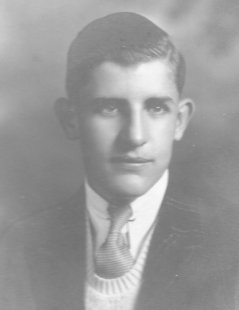
 The pilot of the aircraft was Charles Melvin
Kirschner. Charles was born in mid December 1915 in St
Joseph, Missouri to Joseph and Laura Lucetta Kirschner. He
attended Benton High School in the city where he is recorded in
the 1933 school year book with the following personnel
quote: "A quiet nature is often
deep".
The pilot of the aircraft was Charles Melvin
Kirschner. Charles was born in mid December 1915 in St
Joseph, Missouri to Joseph and Laura Lucetta Kirschner. He
attended Benton High School in the city where he is recorded in
the 1933 school year book with the following personnel
quote: "A quiet nature is often
deep".
St Joseph newspapers included him in mentions of the number of
pupil pilots undertaking training at the local airport,
Rosecrans Field, in 1937, culminating in him undertaking his
first solo flight in January of that year.
He took a job with the Continental Bakery Company and was
employed with them at the time he registered for the draft in
1940. By late 1941, his local papers were reporting on his
departure to Glendale California to undertake flight training
for the Royal Canadian Air Force.
In February 1942, the papers recorded his having completed
flying training in the US for the Canadian forces and that he
was visiting his parents on leave
The portrait photo at left is from a newspaper article in
December 1942: Charles M.
Kirschner was with the R. A. F. in England when this picture
was taker. Word has been received by his parents, Mr.
and Mrs. J. P. Kirschner, rural route No. 6, that in October
he was transferred to the United States air force in England
as a lieutenant. He left St. Joseph to begin training with
the English at a field in California a year ago and in March
arrived in England. He is 27 years old.
After the entry of of the United States into the war in 1941,
Charles transferred from the RCAF to the USAAF and by November
1942 at least was flying with the 350th Fighter Group's, 346th
Fighter Squadron when he collided on the runway of RAF
Coltishall with an RCAF Beaufighter while flying a Spitfire
fighter.
In 2005 the 350th Fighter Group historian Hugh Dow, via Bob
Shifflet advised that:
2nd Lt. Charles M. Kirschner
346th Sq
P-39L
5 Feb. 43
Took off as part of a 5 a/c flight from Lands End,
England and on 6 to 7 hr to Port Lyautey, French Morocco,
over Bay of Biscay, ran into severe weather front.
Flight broke up - Kirschner tried to return to
England. Missed - ended up over Southern
Ireland. Flew around for nearly one hour. Unable
to figure out his location. Finally belly landed near
south coast. Turned over to Allied control two days
later at border with Northern Ireland.
Hugh Dow further reported:
Yes, Lt. Charles W. Kirschner,
346 Fighter Squadron, ex RCAF/RAF, did crash land on the
southern part of Ireland, on 5 February 1943. He was
part of a five ship P-39 flight that took off from RAF
Station Predannack, on Lands End, with destination Port
Lyautey, French Morocco, following a B-25. Out over
the Bay of Biscay they ran into a severe line squall and the
flight broke up while attempting to penetrate. Two of
the pilots, Lt. Duket of Hq. 350 Gp and Lt. Tedford
of 345 Sq. rejoined after penetrating the front and made
it to destination. One 347 Sq. pilot, Lt. Clyde Wilson,
flew east to establish his position, encountered the coast
of France and turned out to sea again, before heading
south. While over Spain he decided he no longer had
enough fuel to reach French Morocco and chose to crash land
on a small Spanish airfield. After a couple of months
the diplomats worked out the details and he was permitted to
proceed to Gibraltar, under cover, and rejoined his Squadron
in Africa. Another pilot in the flight, Lt. Henry M. Nelson,
apparently got through the front and continued south towards
his destination. He was spotted by Lt. Hermann
Horstmann who was patrolling over the Bay as a member of
KG/40, in a fighter version of the Ju-88, looking for lone
allied aircraft to intercept. It is assumed that
Nelson was still flying near the deck at maximum range
cruise speed about 165 MPH when he was intercepted from
behind by Horstmann and was shot down and killed. (See
Chris Goss s Bloody Biscay for further details)
The fifth pilot in the flight, Kirschner, decided to
return to England when the flight broke up in the weather
front. He found a hole to let down through over a
green countryside but could not establish his position and
after burning up most of his fuel crash landed in southern
Ireland, not knowing till afterward that he had landed there
instead of England. He was released a couple of days
later at the border with Northern Ireland.
One more pilot, Capt. Robert L. English, made a
precautionary landing at Lisbon on the 8th after loosing all
electrical systems. These losses, combined with the
major loss of 10 345 Sq. aircraft an pilots that landed at
Lisbon on 15 January 43 when they ran short of fuel after
dodging frontal storms, accounted for the fourteen (out of
75 aircraft) 350th Group losses during the move during the
middle of winter, by many pilots with only 20 hours in the
P-39, from England to Africa. The last flight by the
Groups pilots took place on 28 February 43.
His local papers again reported in July 1943 that he was back
in the United States on a 30 day period of leave and visiting
his parents. He can be found on the morning reports for
the Billings General hospital, Fort Benjamin, Indiana in early
August 1943, being returned to duty at Stout Field,
Indiana. he was still in the US in February 1944, visiting
his parents again while preparing for a transfer to Virginia
from Minneapolis.
At some point during 1944, he was deployed overseas
again. Late in 1944, his local newspapers would publish
news of his award of the Air Medal for his service. The
St. Joseph Union Observer also carried a longer article a few
weeks before.
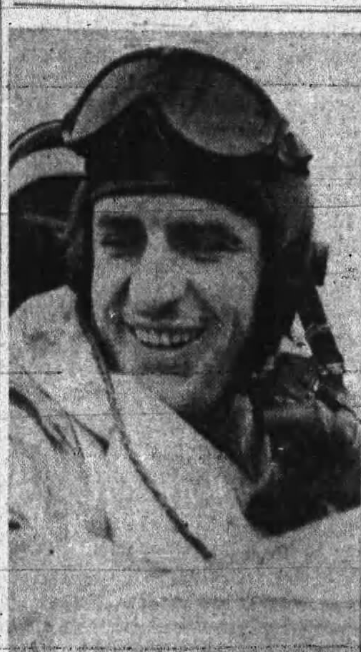 Air Medal to Kirschner, Thunderbolt Pilot
Air Medal to Kirschner, Thunderbolt Pilot
AN 8TH AIR FORCE FIGHTER STATION, England.
P-47 Thunderbolt-pilot, 1st Lt. Charles Kirschner, son of
Mr. and Mrs, Joseph P. Kirschner of St. Joseph, has been
awarded the Air Medal for- "meritorious achievement in
sustained combat operations over Germany." Announcement of
the award was made by the 356th Fighter Group commander, Lt.
Col. Philip E. Tukey Jr. of Cape Elizabeth, Maine.
Lt. Kirschner was a pilot with the RAF
from March, 1942, to May, 1943. He transferred to the U.S.
Army Air Force, joining this group in September, 1944. The
flyer was with the Continental Baking Company in St. Joseph
before enlisting in the Royal Air Force for flying duty.
The following January 1945, the same newspaper was reporting an
Oak Leaf Cluster award Air Medal. He featured in another
St. Joseph New Press article in July 1945 where he, his brother
and fourteen cousins were written about as the serving grandsons
of 84 year old Mrs Rosa Kirschner. His awards are all
recorded in card files in the US National Archives and all award
orders appear to be issued by the 1st Air Division of the Eighth
Air Force. December 1945 would find the St. Joseph papers
recording the re-union of his parents with their three children,
Hildabright, Charles and Joseph Jr. His discharge from the
Air Force was announced that following January, his service
finishing up at Santa Ana, California.
In 1950, he was a National Guard pilot and civilian flight
instructor in St Louis.
He passed away in July 1967 in Dade County, Florida where he
lived with his wife and stepson.
Compiled by Dennis Burke, 2025. Sources: Irish Military
Archives File: G2/X/1138, Newspapers mentioned in text from
Newspapers.com and britishnewsarchive.co.uk, Records sourced via
Ancestry.com and archives.gov.
